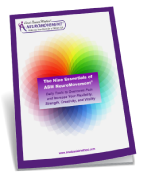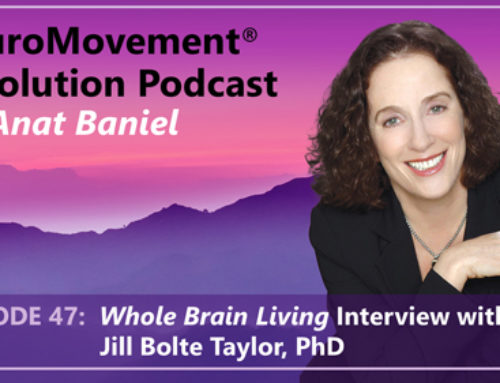The Use of Ankle-Foot Orthotics (AFOs) with the Child with Cerebral Palsy
Article by Anat Baniel

When a child with cerebral palsy and spasticity in the ankles, feet, and legs is brought to me, I have noted that usually that child has been fitted with ankle-foot orthotics (AFOs). This is also the case with children who are unable to be upright, sitting or standing, and who have not yet figured out how to bear weight on their feet.
The reasons given for using AFOs are:
- to correct for the ongoing muscular pull in the feet and ankles created by the spasticity
- to avoid distortion in the formation of the joints in these parts.
There also seems to be an underlying belief that if somehow the feet and ankles are forced to be “straight,” then the child will be able to stand and walk.
The attempt to eliminate distortion in the feet and ankles is both understandable and important. But whether or not using AFOs is the best way to go about trying to achieve this goal deserves questioning. In search of answers, I suggest we look at how children without special challenges learn to use their feet and ankles. The underlying idea is that in order to learn to use their feet for standing and walking, the nervous systems of children with special challenges will need to go through a similar process to that of all other children.
Development of Children Without Special Challenges
After a typical baby is born, for the first few months she will be unable to bear weight on her feet. What she does during that period will be to spontaneously move her legs in many different directions.
Some of these movements inevitably result in the child’s feet touching people and objects nearby. While touching Mom, Dad, the crib mattress, or any other surface with her feet, the typical baby will apply pressure and thus experience weight bearing as forces travel through the skeleton repeatedly, and in complete safety, long before she will attempt to be upright.
The feet of a typical child will touch and press into these surfaces from all directions: sometimes with the sole of the foot, sometimes with the top of the foot, sometimes with the inside of the foot and sometimes with the outer border of the foot. In other words, there is great variability in how the feet come in contact with the world around it. At this important developmental stage the baby is not expected to use the feet in any particular way and as a result is not perceived as doing it “right” or “wrong.” As time goes on, the baby will get to grab her feet and bring them to her mouth. As she learns to crawl on her belly, often she will discover that pushing on the toes helps propel her forward.
As she acquires more and more movement skills on the way to standing up, she experiences her feet continuously in new ways in the context of evolving new movement configurations. In other words, the baby learns to KNOW her feet, and gradually learns to control them through continuous variations in movement, in kinesthetic experiences, in interactions between the feet and their surroundings and in the different outcomes that occur as a result of these movements and interactions.
Children With Spastic Feet, Ankles, and Legs
In comparison, the child whose feet, ankles, and legs are spastic, because of the spasticity, is denied the opportunity to discover his own feet in the same way that other children do. The spasticity stops most of the random and spontaneous movements a baby would otherwise be doing. The lack of the many variations in movement deprives the child of the wealth of sensations, feelings, and outcomes he needs to experience in order for his brain to form patterns of voluntary movements in the feet and ankles.
An important aspect to remember is that the child learns to use his feet in the context of learning to use the rest of his body. The gradual process of learning to use the feet effectively occurs while the baby is also learning to use his back and pelvis, carry his head, orient himself in space, and bear weight on his hands and arms.
Just as with the development of the brain’s ability to organize the movement of the feet, normal brain development regarding the whole body requires great variability in random and spontaneous movement and experiences. That wide range of experience provides the baby’s brain with the opportunity to learn to organize the whole body and to coordinate the movements of the feet with the movements of the entire body.
The child with spastic feet and ankles usually lacks the opportunity to form well-organized movement in the rest of her body. As a result, the brain cannot form proper dynamic relationships between the feet, ankles, and the whole body. That makes it even more difficult for that child to connect to her feet and bring them into intentional and effective use.
The Impact of AFOs
The use of AFOs approaches the body and its functioning from a static point of view. When we place braces on the feet, ankles, and legs of a child with cerebral palsy in an attempt to force them into a position that is more “correct” or “normal,” we are aggravating the underlying problem. By fixing the feet and ankles in braces, there will be even less opportunity for variability in movement. The environment becomes frozen— the inside of the braces—and thus there is less opportunity for the child to sense and feel that area of her body.
There is reduced opportunity to form a proper dynamic relationship between the feet, ankles, and the rest of the body because with the AFOs in place, no matter how the child organizes and moves her body, the legs remain fixed. In other words, the use of AFOs reduces the opportunity for the child to learn to use her feet through self-correction and by approximations.
The Anat Baniel Method for Children
In the Anat Baniel Method for Children, we focus on helping the child to reduce spasticity in the ankles and feet by simulating for the child, what children who do not have spasticity experience. We attempt to create gentle, safe conditions for the child in which she is not asked to be more upright than she can be. We have the child experience her feet in as many different ways as possible. At the same time, we focus on the rest of the body and see that the feet and ankles are authentically and dynamically connected to the movements of the body.
Once the child begins to bear weight on her feet, we avoid placing any demand or expectation for it to be done “correctly” from the start. Through continued learning and novel experiences the child will gradually learn to self-correct the foot. It is not the case that a child with cerebral palsy is less of an effective learner than other children, it is rather that the spasticity denies the child the richness and constant flow of experiences, kinesthetic information, and successes and failures that are the basis for all development.
Read about the story of Isabel here.
Previously published in Cerebral Palsy Magazine, December, 2003
Copyright 2003, Anat Baniel Method. All rights reserved.





